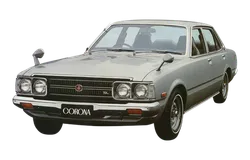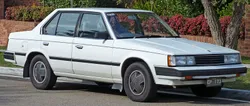

Toyota Corona - Generation 8 E150 T160 Facelift
Explore the Toyota Corona Generation 8 E150 T160 Facelift from 1983 in Portugal. Discover its features and specifications, perfect for enthusiasts and collectors.
The Toyota Corona has long been a staple of the automotive landscape, evolving through multiple generations while retaining its core attributes of reliability and practicality. The eighth ...
Technical Specifications
Select Version
Dimensions
Engine
Driving
Others
History and Features
Mycarro AI
Apr 27, 2025
The Toyota Corona has long been a staple of the automotive landscape, evolving through multiple generations while retaining its core attributes of reliability and practicality. The eighth generation, known as the E150 and T160 models, represents a significant evolution from its predecessors, particularly with the facelift introduced in 1983. This particular iteration of the Corona was produced from 1981 to 1987 and played a crucial role in solidifying Toyota’s reputation as a manufacturer of efficient, durable, and family-friendly cars.
Design and Styling
The 1983 facelift of the Toyota Corona introduced notable design elements that set it apart from earlier models. Featuring a sleeker profile, the new generation embraced a more modern aesthetic. The updated front end included a redesigned grille and headlights, giving the vehicle a more assertive and refined appearance. Additionally, the angular bodylines and slightly elongated shape enhanced aerodynamics, contributing to improved performance and fuel efficiency, which was becoming increasingly important to consumers of the era.
Inside, the Corona offered a spacious and comfortable cabin, typically fitted with high-quality materials for its class. The layout was driver-centric, with a clear focus on functionality. The introduction of ergonomic seating and ample storage options added to the overall driving experience. While it may not have featured the advanced technology present in contemporary vehicles, the Corona’s user-friendly interfaces and practical functionalities were well-received by families and individuals alike.
Engine Performance
Under the hood, the E150 and T160 generation of the Toyota Corona featured a variety of engines tailored to meet diverse market demands. The available powertrains included both gasoline and diesel options, ensuring consumers could select a model that matched their driving preferences. The most common engine was the 2.0-liter 18R series, presenting a balanced combination of power and efficiency. This engine produced a respectable horsepower output, making it capable of handling city commutes as well as longer road trips with ease.
The introduction of the 1.8-liter 3S engine in later models was particularly notable for its enhanced fuel efficiency and smoother performance. Despite the relatively modest power figures, these engines were known for their longevity and reliability, perfectly aligning with the Toyota ethos of building resilient vehicles. The added benefit of various transmission options, including manual and automatic gearboxes, further catered to a wide array of driver preferences.
Driving Experience
The driving dynamics of the 1983 Toyota Corona were designed to offer a balanced experience. The independent front and rear suspension systems contributed to a smoother ride, absorbing bumps and road imperfections effectively. Drivers appreciated the Carona's predictable handling, making it a favorite among those who valued comfort over performance. While it was never marketed as a sports car, the Corona's driving characteristics offered a reassuring sense of control that appealed to many in the family-oriented market segment.
Market Position and Legacy
During the eighth generation's production run, the Toyota Corona found itself in a fiercely competitive automotive market. It competed against rivals like the Honda Accord and Nissan Bluebird, but its reputation for reliability often proved to be its trump card. Families and professionals alike valued the Corolla for its combination of space, comfort, and dependability at a reasonable price point.
The success of the E150 and T160 series set in motion a strong legacy that would continue for subsequent generations of the Corona. Many of the design principles and engineering philosophies introduced during this era influenced Toyota's future models, underlining the importance of the Corona in the company's broader narrative.
Conclusion
The Toyota Corona Generation 8 (E150, T160) facelift of 1983 remains a significant chapter in the history of one of Toyota's most esteemed models. Combining practical design, reliable performance, and substantial technological advancements for its time, it served the needs of a diverse group of drivers and their families. As the automotive landscape continued to evolve, the traits established in the eighth-generation Corona would resonate for years to come, ensuring its place as a beloved classic in the hearts of many Toyota enthusiasts.
